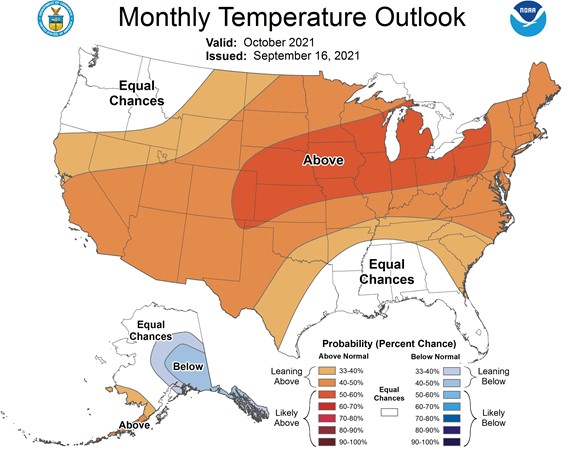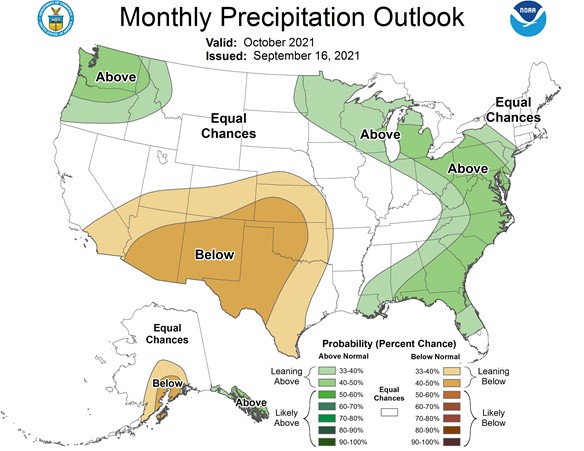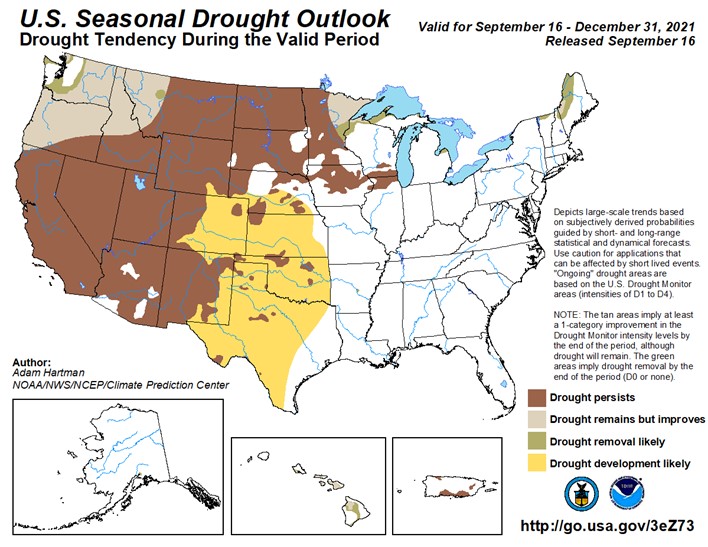Climate and Drought Outlook for the United States
The National Oceanic and Atmospheric Administration (NOAA) Climate Prediction Center El Niño/Southern Oscillation (ENSO) September 2021 update indicated that overall, the ocean-atmosphere system reflected ENSO-neutral conditions but is trending toward La Niña. Over the next few months, a transition from ENSO-neutral to La Niña is favored, which a 70 to 80 percent chance of La Niña emerging in the winter of 2021-2022 in the Northern Hemisphere. To read more, click here.
The NOAA Climate Prediction Center (CPC) one-month outlook for October 2021 predicts that above-normal temperatures are probable across most of the continental United States (CONUS). Areas in the Midwest, western Northeast, and central Great Plains are projected to have the greatest probability of above-normal temperatures (50 to 60 percent chance). Regions in the South and Pacific Northwest are the only areas of the CONUS expected to have temperatures near normal. No areas of the CONUS are projected to have below normal temperatures in October 2021. To view NOAA CPC outlook updates, click here.


This map depicts the probability of below, near, or above normal temperatures during the one-month period of October 2021. (Map courtesy of NOAA’s Climate Prediction Center).
The NOAA CPC one-month outlook for October 2021 forecasts above-normal precipitation in parts of the Midwest, Southeast, Mid-Atlantic, and Midwest, with probabilities ranging from 33 to 50 percent. The greatest probabilities of above-normal precipitation (40 to 50 percent probability) are located in swaths encompassing multiple states within these regions. The latest NOAA CPC 2021 Atlantic hurricane season outlook press release indicates that the hurricane season has begun, and remains conducive for an above-average hurricane season. The number of expected named storms (winds of 39 mph or greater) is 15 to 21, including 7 to 10 hurricanes (winds 74 mph or greater), three of which could become major hurricanes, (Category 3, 4, or 5 with winds 111 mph or greater). This projection accounts for the 19 named storms that have formed this year so far. NOAA CPC models forecast a 65 percent chance of an above-normal Atlantic hurricane season, a 25 percent chance of a near-normal season, and a 10 percent chance of a below-normal season. The Atlantic hurricane season began on June 1st and ends November 30th.
The NOAA CPC projects below-normal precipitation across regions of the Southwest, southern Great Plains, and most of Texas (33 to 50 percent probability). The greatest chance of below-normal precipitation in the CONUS (40 to 50 percent probability) is forecasted across extensive areas of Arizona, New Mexico, Texas, Oklahoma, Colorado, and Kansas. The lack of precipitation in these areas is projected to cause drought conditions to persist or further develop (see the U.S. Seasonal Drought Outlook below). To view an interactive map of NOAA’s Seasonal Climate Outlook, click here.


This map depicts the probability of below, near, or above normal precipitation during the one-month period of October 2021. (Map courtesy of NOAA’s Climate Prediction Center).
According to the NOAA U.S. Seasonal Drought Outlook, covering September through December 2021, existing drought conditions are expected to persist across the West and western side of the Midwest, in addition to pockets spanning from Texas northward to Nebraska. Further drought development is expected to occur in parts of Texas, Oklahoma, New Mexico, Colorado, Kansas, Nebraska, and Wyoming. It is projected that the rest of the areas previously under drought, notably areas in the Pacific Northwest and Northeast, as well as some areas bordering Lake Superior and Lake Huron, will either improve or drought conditions will be alleviated entirely. To view the latest NOAA U.S. Seasonal Drought Outlook map, click here.


This map depicts a nationwide outlook of seasonal drought during the period of September 2021 through December 2021. (Map courtesy of NOAA/NWS/NCEP/Climate Prediction Center).
The links below will direct you to the NOAA Climate Prediction Center, which includes information on ENSO, climate, and drought outlooks, as well as other forecasts and models.
Recommended Sites
- National Oceanic and Atmospheric Administration (NOAA): Seasonal Drought Outlook
- National Integrated Drought Information System: U.S. Drought Portal
- Climate Prediction Center ENSO (El Niño/La Niña-Southern Oscillation) Update
- NOAA Climate Prediction Center
- NOAA Climate Seasonal Media Release
Additional Information and Data
- International Research Institute for Climate and Society: Model Forecasts
- NOAA: Precipitation Required to End the Drought
- NOAA: La Niña Information
- NOAA: La Niña Anomaly
- NOAA: Presentations on El Niño and La Niña, Predictions, Drought Status
- National Drought Mitigation Center: Predicting Drought
- NOAA National Hydrologic Assessment


